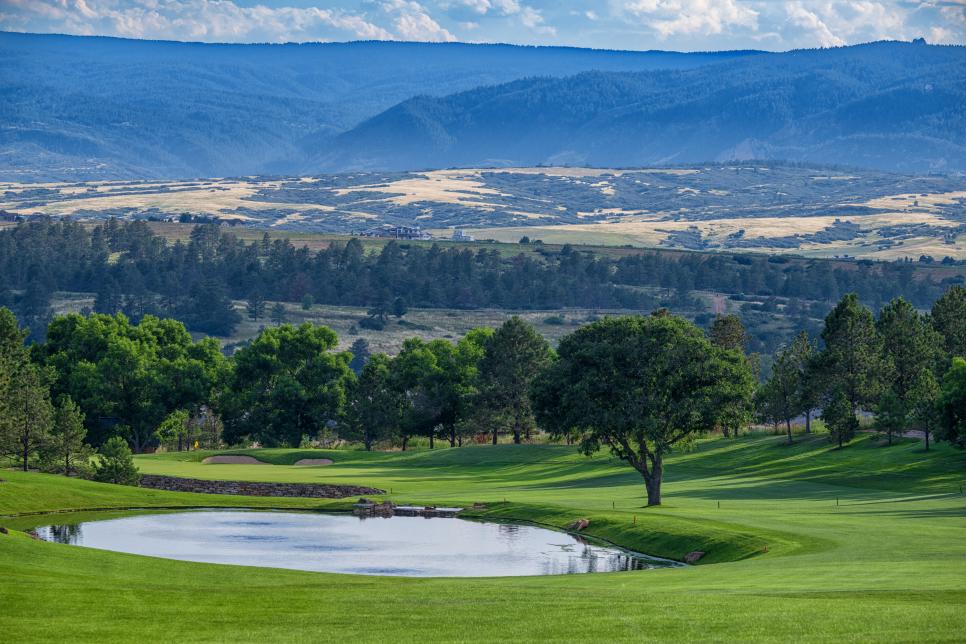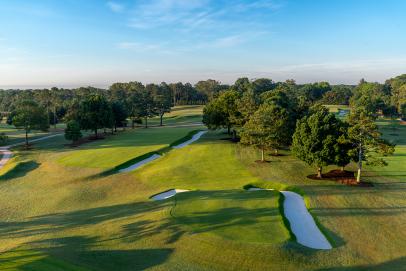Castle Pines: How the course’s 5 most interesting holes will decide the BMW Championship – Australian Golf Digest

- by Admin
- August 22, 2024

When Castle Pines Golf Club hosts this week’s BMW Championship, it will look a lot different from the last time the PGA Tour visited the course in 2006, the last year of The International.
Created by Castle Pines founder Jack Vickers, The International was one of the most unique events on the schedule. Held for 21 years, it was based on a modified Stableford scoring system that promoted aggressive play by awarding more points for birdies and eagles than it subtracted for bogeys and doubles.
RELATED: Our expert’s review of Cabot Citrus Farms reveals why the Karoo course is golf’s most unique new design
The format included a series of cuts and daily playoffs to advance, including a 12-man Wednesday shootout in the tournament’s first year. Winners included Greg Norman, Jose Maria Olazabal and Ernie Els. Davis Love III and Phil Mickelson each won twice. One of the tour’s most dramatic finishes occurred in 2002, when former winner Steve Lowery caught fire and ran up a record 14 points over a four-hole stretch from 14 through 17 before lipping out the winning birdie putt on 18 and losing to Rich Beem by one.
Watch our Every Hole at Castle Pines video below:
In the intervening years, Castle Pines has invested tens of millions of dollars in upgrades to the golf course, clubhouse and surrounding amenities. Even so, the 1981 Jack Nicklaus design, 30 miles south of Denver and ranked 48th on America’s 100 Greatest Courses, remains essentially what it’s always been: a manicured, parkland-style course that roams though the Ponderosa pines on a rugged Rocky Mountain foothill site.
Courtesy of the club
Each nine begins at the top of the property, working off steep elevations and then circles through lowlands before making the return ascent. Most tees offer panoramic views of the Colorado Front Range, and balls seem to soar forever in the mile-high air before plunging down to the slender, bending fairways and greens.
Many of the individual holes, however, have changed significantly, including two, three, five and 16. The par 4 second, for instance, used to utilize a rambling ravine as a sandy hazard crossing the front of the green. That’s been replaced by a small reflection pond. The same ravine once split the par 4 third into left and right fairways giving players driving options depending on strategy and pin position on the green. The left fairway was converted in 2020 into a long, rock-lined water feature. Bunker styles and positions were adjusted, and almost every green has been remodeled or recontoured in some fashion.
The course will play over 8,100 yards from the BMW tees, though that will translate to roughly 7,300 yards since the course altitude is over 6,000 feet above sea level. That distance is lessened even more by some of the downhill drives, particularly at the par-5 first and par-4 10th, off-set only slightly by uphill but reasonable approaches at five, six, nine and 17.

The newly redesigned par-4 third.
CHANNING BENJAMIN
Scoring is likely to come down to three basic factors. One, drives must avoid the thick bluegrass rough that will impact the ability to control spin. That’s critical because, two, it is imperative to keep the ball under the hole on the greens. The putting surfaces don’t possess significant contour, but slopes and shoulders protruding in from the edges create bending putts across levels and slick downhill putts that will put the field on the defensive, especially at elite tournament speeds.
The third factor is the set of par 5s: Given the altitude, every player in field has the ability to reach them in two shots, most with irons, and to be in contention on Sunday it will be important to go deep with the scores on these four holes.
Here are the holes to watch at Castle Pines.
HOLE 8: PAR 5, 601 YARDS 
After a series of holes that run through an open, prairie-like western flank of the course, eight moves back into the pines with a slightly uphill drive that must stay short of a pair of bunkers on the left. If players can find the fairway they’ll hit second shots toward the base of a hill and a new green that was shifted 35 yards back and to the left in 2021. It’s one of the smaller, more challenging targets to hit and hold, boxed by four bunkers, and there are limited hole location due to the severe pitch of the surface. The field should have no problem getting shots around the green in two, but they’ll likely need make their fours by getting up and down.
HOLE 9: PAR 4, 495 YARDS 
The water feature running down the right side of the hole was one of the first that Vickers added, replacing the dry wash that was there when Nicklaus designed the hole. Between the water and three fairway bunkers opposite there’s no room to miss off the tee. During an early mid-tournament cut, Fuzzy Zoeller pulled his drive over the ridge that defines the left side of the hole. “What’s down there?” he asked his caddie. “The United Airlines counter,” came the reply.
The real challenge of the ninth is the blind, uphill approach to a shallow, terrifyingly tilted green. Pins set on the front left over a false front are nearly impossible to hold, and it’s not unheard of for golfers to putt off the green when it’s cut there. Back-right flags are slightly easier—as long as second shots stay under the hole.
More from Golf Digest  East Lake Revival Why the Tour Championship is going to look drastically different this year at East Lake HOLE 10: PAR 4, 545 YARDS
East Lake Revival Why the Tour Championship is going to look drastically different this year at East Lake HOLE 10: PAR 4, 545 YARDS 
Carlos Amoeda
Players standing on the elevated 10th tee will aim their drives at Castle Rock in the distance and hope when the ball comes down it’s on the fairway. If it isn’t they’ll have to make a decision about whether to go for the green that’s set on the far side of a water hazard or lay up and try to make par from 110 yards. The bunkerless 10th is lovely but long, plain but punitive, and it routinely played as the course’s most difficult during The International with an average score of almost 4.5. Players who get through Nos. 9 and 10 in eight strokes will pick up ground on the field.
More From Golf Digest  Golf Digest Logo America’s 100 Greatest Golf Holes HOLE 16: PAR 3, 226 YARDS
Golf Digest Logo America’s 100 Greatest Golf Holes HOLE 16: PAR 3, 226 YARDS 
CHANNING BENJAMIN
The previous version of the par-3 16th was as polarizing as any hole at Castle Pines and often seemed impossible to play, especially when the pin was cut on the elevated back left lobe of the green above one of the deepest pot bunkers on the course. The new version, following a radical 2015 transformation, is hardly meek, though it should at least be recognizable as a modified version of the 16th at Augusta National. Requiring a long tee shot over a water feature that didn’t previously exist, the green is angled right to left over the hazard and divided into high and low sections. Hole positions on the upper right half are extremely difficult to access and protected by bunkers short and through the green (like Augusta). When they’re placed on the lower level close to the water, players can use the embankment to swing balls close to the hole, just like the traditional Sunday flag at The Masters.
HOLE 17: PAR 5, 532 YARDS 
The par-5 17th is shorter than the par-4 10th, though the yardage is balanced by the uphill topography. It’s a lovely hole that bends around a corner of pines with a burbling creek running along the left edge of the fairway. It was usually the swing hole during Internationals, giving players a chance to pick up a late pile of points with a birdie or eagle. During his improbable run in 2002, Steve Lowery actually jarred his second for an eight-point double eagle to thunderous applause. Playing one hole ahead on 18, leader Rich Beem assumed it was a five-point eagle and asked CBS reporter David Feherty if Lowery had made a three. Beem’s heart sunk when Feherty held up two fingers, though he was able hold on for the win.
Drives must avoid two recently added fairway bunkers on the right, and if that’s accomplished players may have as little as eight- or nine-irons into the blind green plateaued into a steep hillside. Once again, it’s crucial to stay beneath the hole on approaches on what is yet another wickedly pitched green—even hole-high shots will leave big, bending putts. The exciting 17th will no doubt continue to be the tournament’s swing hole, and it’s likely that someone will win or lose the BMW because of the score they make here.
 Courtesy of the club/Channing Benjamin false Private Castle Pines Golf Club Castle Rock, CO, United States 4.6 145 Panelists
Courtesy of the club/Channing Benjamin false Private Castle Pines Golf Club Castle Rock, CO, United States 4.6 145 Panelists
- 100 Greatest
- Best In State
When Golf Digest began its annual Best New Course awards in 1983, the review panel selected Castle Pines as the Private Course winner, but Bill Davis, co-founder of Golf Digest and founding father of all its course rankings, didn’t care for the course and vetoed its inclusion. So no private course was honored that year. Davis soon recognized his error, and in 1987—its first year of eligibility—Castle Pines joined America’s 100 Greatest and has remained there ever since. Club founder Jack Vickers, a Midwest oilman, had urged architect Jack Nicklaus to produce a mountain-venue design worthy of a major championship. Jack did, but when a championship never resulted, Vickers established his own, The International, which for many years was the only PGA Tour event played under a unique Stableford format. It’s a pity that The International is no longer on the Tour’s schedule. Like Muirfield Village, the only other solo Nicklaus design in the top 50, Castle Pines has undergone a steady procession of hole alterations to keep pace with changing technology, and changing tastes. Explore our course review
• • •
Explore Golf Digest’s new Course Reviews section where you can submit a star rating and evaluation on all the courses you’ve played. We’ve collected tens of thousands of reviews from our course-ranking panelists to deliver a premium experience, which includes course rankings, experts’ opinions, bonus course photography, videos and much more. Check it out here!
More From Golf Digest  FedEx Cup Who’ll win the 2024 FedEx Cup? Here are 5 common traits among the past 17 champions
FedEx Cup Who’ll win the 2024 FedEx Cup? Here are 5 common traits among the past 17 champions .jpg.rend.hgtvcom.406.406.suffix/1720466003157.jpeg) Branded Content Preparation Pays Off for Davis Riley
Branded Content Preparation Pays Off for Davis Riley  Branded Content Fitzpatrick and Aon Deliver on Data
Branded Content Fitzpatrick and Aon Deliver on Data
This article was originally published on golfdigest.com
The Latest News
-
January 9, 2025Sahith Theegala pledges $100 per birdie and $250 per eagle at the Sony Open toward L.A. wildfire relief – Australian Golf Digest
-
January 9, 2025Aus Open injury fears for Kokkinakis as star pulls out of key match
-
January 9, 2025‘A lot to like’: What to know about Aussie Test bolter
-
January 9, 2025‘Hadn’t truly deserved it’: How Ashes stalemate proved England could end decade of pain
-
January 9, 2025How to watch Australian Open: TV channel, live stream for AO 2025 tennis | Sporting News Australia





